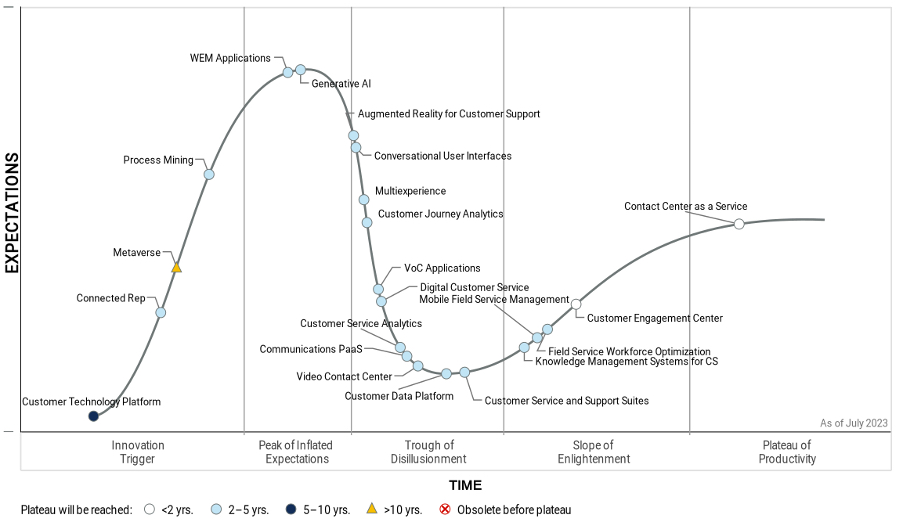Generative AI, digital customer service and conversational user interfaces (CUIs) apparently are the answer to what has proved a tough nut to crack in telecoms
Gartner predicts that three technologies will radically improve customer service by 2028. We can only hope but the fact is technology is only part of the solution; how good it is depends on how well it is executed and technologists are often the not the best judges of what constitutes good CX.
That aside, the Gartner Hype Cycle for Customer Service and Support Technologies, 2023 report describes how the maturity of the technologies varies, from “embryonic” customer technology platforms to “highly hyped” generative AI and “mature…with significant adoption opportunity still remaining” for contact centre-as-a-service.
More than half of the innovation profiles included in the hype cycle are currently languishing in the trough of disillusionment, as shown in Figure 1.
Figure 1: Gartner Hype Cycle for Customer Service and Support Technologies, 2023

Source: Gartner (August 2023)
Drew Kraus, VP Analyst at the Gartner Customer Service and Support practice, says, “The common theme of these three technologies are their ability to streamline the customer journey and enable customer service leaders to meet customers’ growing expectations. Within the next five years, we expect these technologies to change the face of customer service and support.”
Generative AI
Gartner predicts that by 2025, 80% of customer service and support organisations will be applying generative AI technology in some form to improve agents’ productivity and customer experience (CX). Generative AI, which has hit the peak of inflated expectations, will primarily be used to create content, chatbots supported by AI and automating human tasks.
Its biggest impact is likely to be on customer experience. A recent Gartner poll showed 38% of leaders see improving customer experience and retention as the primary purpose of deploying applications trained on large language models.
“The impact of AI on the customer service function cannot be overstated,” said Kraus, “Not only do we expect organisations to replace 20-30% of their agents with generative AI, but also anticipate it creating new jobs to implement such capabilities.”
Conversational user interfaces
CUIs are human-computer interfaces that enable natural language interactions to fulfil requests such as answering a question or completing a task. CUIs provide direct control between the customer service agent and the applications they operate. When used to automate support via chatbots, this technology improves customer experience and self-service adoption – assuming of course they are executed well, which is not guaranteed.
“Customers increasingly expect to be able to interact with the applications they use in a natural way, and this has been accelerated by the emergence of large language model-enabled enterprise applications, such as OpenAI’s ChatGPT and Microsoft 365 CoPilot,” said Kraus. “CUIs will be vital for driving efficiency and meeting customers’ changing expectations.”
Digital Customer Service
As digital engagement channels proliferate, customers have come to expect instant and effortless customer service, Gartner says. Introducing more channels can increase the onus on customers as they move between them.
Digital customer service must focus on seamless orchestration of conversations across digital channels to address this. The emergence of conversational AI is evolving self-service models and Gartner expects a new area of customer care which it calls ‘digital customer service’.
Kraus reckons, “Digital customer service will transform customer experience outcomes by reducing friction and eliminating unnecessary customer effort. By creating a seamless customer experience, this technology will reduce churn and enhance customer satisfaction.
Gartner clients can read more in Hype Cycle for Customer Service and Support Technologies, 2023.



